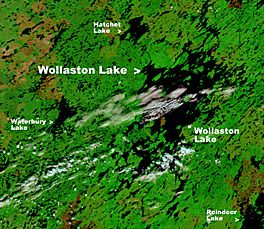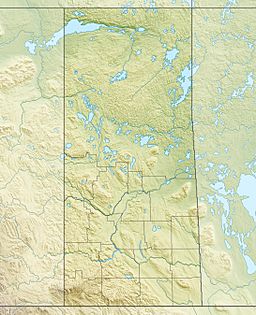Wollaston Lake facts for kids
Quick facts for kids Wollaston Lake |
|
|---|---|

NASA image of Wollaston Lake
|
|
| Location | northeastern Saskatchewan |
| Coordinates | 58°15′N 103°20′W / 58.250°N 103.333°W |
| Type | Glacial lake |
| Primary inflows | Geikie River |
| Primary outflows | Fond du Lac River (10%) Cochrane River (90%) |
| Catchment area | 20,000 km2 (7,700 sq mi) |
| Basin countries | Canada |
| Surface area | 2,681 km2 (1,035 sq mi) |
| Average depth | 20.6 m (68 ft) |
| Max. depth | 97 m (318 ft) |
| Water volume | 39.8 km3 (32,300,000 acre⋅ft) |
| Shore length1 | 1,475 km (917 mi) |
| Surface elevation | 398 m (1,306 ft) |
| Settlements | Wollaston Lake, Saskatchewan |
| 1 Shore length is not a well-defined measure. | |
Wollaston Lake is a large and special lake located in northeastern Saskatchewan, Canada. It is about 550 kilometers (340 miles) northeast of Prince Albert.
This lake is known as the world's largest bifurcation lake. This means its water naturally flows out in two different directions. It has a surface area of about 2,286 square kilometers (883 square miles), not counting its islands. If you include the islands, it's about 2,681 square kilometers (1,035 square miles).
About 10% of the lake's water flows northwest into the Fond du Lac River. This river then joins Lake Athabasca and eventually reaches the Arctic Ocean through the Mackenzie River system. The other 90% of the water flows northeast into the Cochrane River. This river leads to Reindeer Lake, which then drains into Hudson Bay via the Churchill River system.
The main river flowing into Wollaston Lake is the Geikie River, coming from the southwest. If we consider Hudson Bay as part of the Atlantic Ocean, then the Geikie River is the largest river in the world that naturally flows into two different oceans.
Wollaston Lake is the biggest lake completely within Saskatchewan. However, parts of Lake Athabasca and Reindeer Lake that are in Saskatchewan are even larger.
Explorers learned about this unique lake a long time ago. Samuel Hearne heard about it in 1770. In 1796, David Thompson noted its two outlets, calling it "perhaps without parallel in the world." Later, in 1807, Peter Fidler named the lake after William Hyde Wollaston.
The only community right on the lake's shores is also called Wollaston Lake. This community includes the northern hamlet of Wollaston Lake and the nearby village of Wollaston Post, which is home to the Hatchet Lake Dene Nation.
Getting to Wollaston Lake
It is possible to reach Wollaston Lake in a few ways. There is a community airstrip called Wollaston Lake Airport. You can also get there by an all-weather road, Highway 905, which connects to La Ronge.
This road goes along the western side of the lake. The community of Wollaston Lake is on the eastern side. You can cross the lake using a special winter road when the lake is frozen, usually from November to June. When the lake is not frozen, a ferry called the Wollaston barge helps people cross.
Air service is also available to Points North Landing. This is a service center for nearby uranium mines. These mines offer jobs for local people. However, there have been discussions about keeping the lake clean and safe from any possible effects of the mining.
Fish Species in the Lake
Wollaston Lake is home to many different kinds of fish. Some of the fish species you can find here include:
- Walleye
- Yellow perch
- Northern pike
- Lake trout
- Arctic grayling
- Lake whitefish
- Cisco
- Burbot
- White sucker
- Longnose sucker
Water that has been treated from the Rabbit Lake uranium mine is released into Hidden Bay, which is on the southwestern side of the lake.
See also
 In Spanish: Lago Wollaston para niños
In Spanish: Lago Wollaston para niños


